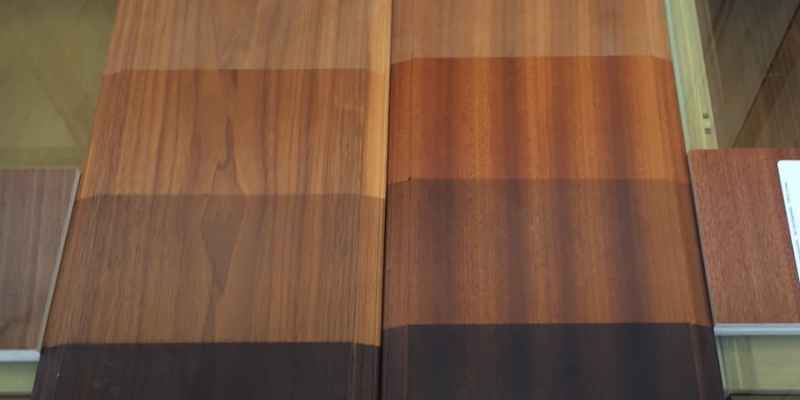Sapele wood is a hardwood used to construct furniture and other wooden objects. It is known for its strength, durability, and durability, and Sapele wood can be finished in various ways, various the look you are looking for.
Here looking some tips on finishing Sapele wood to achieve perfect results.
- Start by sanding the wood with medium-grit sandpaper to smooth out any roughness
- Wipe down the wood with a damp cloth to remove any dust from sanding
- Apply a stain of your choice to the wood using a brush or rag, working in the direction of the grain
- Allow the paint to dry completely before moving on to the next step
- 5 Once the paint is dry, apply a clear coat of polyurethane to protect the finish and give it a glossy sheen
- 6 Allow the polyurethane to dry completely before using or handling the furniture piece

Disadvantages of Sapele Wood
Sapele wood is a beautiful, reddish-brown hardwood often used in high-end furniture and cabinetry. However, Sapele wood has a few disadvantages that should be considered before using it in your next project. One of the most significant disadvantages of Sapele wood is its price.
Sapele wood is one of the more expensive hardwoods on the market, making it for some projects. Additionally, Sapele wood can be challenging to work with because it is tough and denstougheans that itItto cut, sanded, and drilled without the proper tools and experience.
Despite its challenges, Sapele wood can be a stunning addition to any home or office. If you have the budget for it and are willing to take on the challenge of working with this tough wood, Sapele can add beauty and elegance to your space.
Best Treatment for Exterior Sapele
Exterior Sapele is a beautiful hardwood often used for door furniture and siding. Protecting this wood from the elements is essential to keep it looking its best. The best way to do this is by using a good quality sealer or stain.
Is Sapele an Oily Wood
Sapele is a wood that hails from Africa. It is known for its deep, rich color and grain patterns that can range from straight to interlocked. This hardwood is also quite oily, which can be duo work with and finished.
When choosing sapele for your next project, keep these things in mind: -The oiliness of the wood can make it challenging to get a good finish. If you’re planning onyou’reing or painting your project, test the products on a scrap piece of Sapele first to see how they react with the oil.
-Because of its hardness, Sapele can be difficult to work with tools. Make sure your blades are sharp, and take care when n cut or shaping the wood. -Although it’s an oily wood, it is still susceptible to moisture damage.
Be sure to protect your project from excessive moisture during construction and use proper finishes before putting it into service.
Danish Oil on Sapele
Danish oil is a type of wood finish that can be used on various diffevariousSapele. Danish oil is made from a blend of natural oils and resins, and it penetrates penetrating to protect it from moisture and wear. It also gives the wood a beautiful lustrous sheen.
Danish oil is easy to apply and maintain, and it’s an ideal choiit’sor busy households with kids and pets.
How to Darken Sapele Wood
Sapele wood is a beautiful, deep brown wood that can be used for various woodwvariouscts. If you want to darken Sapele wood, you can use a few you can use methods. One sand the wood with increasingly finer grit sandpaper until you achieve the darkness you desirdesired darknesstain the wood with a dark-colored oil-based stain or dye. Another way to darken Sapele wood is to apply black paint or lacquer. This will give the wood a deep, rich color that will stand out.
Just seal the lacquer, so it doesn’t chip or scdoesn’tasily. Whichever method you choose, take your time and experiment until you get the perfect look for your project!
Best Oil for Sapele Wood
There are a few different types of oil that can be used on Sapele wood, but the best option is to use teak oil. Teak oil penetrates deep into the wood and helps to protect it from water damage and rot. It also gives the wood a beautiful lustrous finish.
Sapele Outdoor Finish
Sapele is a dark, reddish-brown wood that is native to West Africa. It is an excellent choice for outdoor furniture because it is highly durable and resistant to rot and insect damage. Sapele can be difficult to work with because it is complex and tends to splinter, so it is essential to use sharp tools when working with this wood.
Sapele Outdoor Finish will protect your furniture from the elements while allowing the natural beauty of the wood to shine through. This finish can be applied by brush, roller, or sprayer and dried to a clean sheen in 24-48 hours.
Sapele Wood Care
Sapele is a beautiful hardwood with a rich, reddish brown color and distinctive grain pattern. It’s often used inIt’sh-end furniture and cabinetry and is also famous for woodworking projects. Caring for Sapele wood is relatively simple, but there are a few things to keep in mind to keep it looking its best.
Here are some cleaning tips, polishing, and protecting Sapele wood: • Dust regularly with a soft cloth or feather duster. If dirt or grime builds up on the surface of the wood, use a slightly dampened cloth to wipe it away.
Avoid using harsh chemicals or abrasive cleaners on sale, as they can damage the finish. • When polishing Sapele wood furniture or cabinets, use a beeswax polish or lemon oil. These natural products will help protect the wood and bring out its natuenhancer.
Apply the polish with a soft cloth, working in small circles until the entire surface is covered. Buff away any excess polish with a clean cloth. • To protect Sapele from scratches and everyday wear and tear, consider applying a thin layer of clear polyurethane varnish over the surface of the wood (this step is optional).
Allow the varnish to dry completely before using or placing anything on top of it. Reapply every few years as needed to maintain protection.
Is Sapele Wood Waterproof?
Sapele wood is a popular hardwood used in various applications, including furniture, cabinetry, and flooring. Its unique grain pattern and reddish hue make it a desirable option for many homeowners and designers. But what about its waterproofing properties?
Unfortunately, Sapele wood is not naturally waterproof. However, this does not mean it cannot be used in wet areas. If you are considering using Sapele wood in a place where it will be exposed to moisture, you will need to take some extra steps to protect it.
One option is to apply a waterproof sealant to the wood before installation. This will provide a barrier against moisture and help keep the wood looking its best for years to come. Another option is to install Sapele wood in an area that ited from the elements, such as under a porch or deck.
By taking these precautions, you can enjoy the beauty of Sapele wood without worrying about water damage.
Does Sapele Take Paint Well?
Sapele is a medium to dark reddish brown wood with a purple tinge. It has a relatively straight grain with an interlocking or wavy grain pattern. The wood is hard and dense with good working properties.
It glues, stains, and finishes nicely, although it can cause blotching when staining if not carefully pre-treated. Sapele takes paint well and can be polished to a high luster.
Does Sapele Go Grey?
Sapele is a type of wood type used in furniture and other woodworking projects. It is known for its durability and beauty, but it can eventually show signs of wear like all woods. One of the most common ways that Sapele looks worn is when it begins to turn grey.
There are a few different reasons why sapele may turn grey over time. One reason is simply due to exposure to sunlight and air. This causes the wood to oxidize, which changes its color.
Another reason the Sapele may turn grey is if it gets wet frequently or isn’t correctly sealed after each use. When water penetrates the wood, it can cause the color to change as well. Finally, Sapele may also start to turn grey if it’s not regularlyit’saned and polished.
Dust and dirt can build up on the surface of the wood, causing it to look dull and lifeless. If you notice your Sapele starting to turn grey, there are a few things you can do to help restore its original color. First, try cleaning it with a mild soap and water solution followed by thorough drying.
You can also try using furniture polish or beeswax on the surface of the wood. If these methods don’t work, you don’t to sand down the surface of the wood and re-stain or seal I t. With proper care and maintenance, your sa pe le furniture should last many years without losing its luster.

Does Sapele Darken With Age?
Sapele is a type of wood that is known for its deep, rich color. While the exact shade of Sapele can vary somewhat from tree to tree, it is generally a dark brown or reddish-brown color. This makes it a popular choice for furniture and other woodworking projects where a dark, elegant look is desired.
One question that sometimes comes up about Sapele is whether or not it will darken with age. The short answer to this question is yes, Sapele does tend to darken slightly as it ages. However, the color change is usually relatively subtle. It shouldn’t be a big problem unless you are trying to achieve an exact match between two pieces of Sapele of different ages.
If you are concerned about your Sapele darkening over time, you can do a few things during the process. One option is to apply a clear finish such as lacquer or varnish. This will protect the wood from UV rays and other environmental factors that can cause it to become darker faster.
Another option is to store your sapele in a cool, dry place out of direct sunlight; this will also help prevent the wood from darkening too quickly. Overall, while Sapele does tend to darken slightly with age, this change should not be considered problematic unless you are trying to achieve an exact match between two pieces of different ages. If you want to help slow down the aging pro, you can apply a clear finish or store your sapele in a cool, dry place from direct sunlight.
Conclusion
Sapele is a beautiful and unique wood that can be used for various woodworking projects. It has a wide range of colors, from light pink to deep red, and its grain patterns are stunning. While Sapele is an excellent choice for furniture and other high-end projects, it can be challenging to work with because it is so hard.
In this blog post, we will share some tips on finishing Sapele wood so that you can show off its natural beauty in your next project. The first step in finishing Sapele wood is to sand it down using progressively finer grits of sandpaper until the surface is smooth. Once the surface is smooth, apply a sealer before applying any finish.
We recommend using a water-based sealer because it will not change the color of the wood as oil-based sealers can. After the sealer has dried, you can then apply your chosen finish. Some good options for finishes include lacquer, shellac, and varnish.
Be sure to follow the manufacturer’s ins manufacturer’s applying any finishes.


